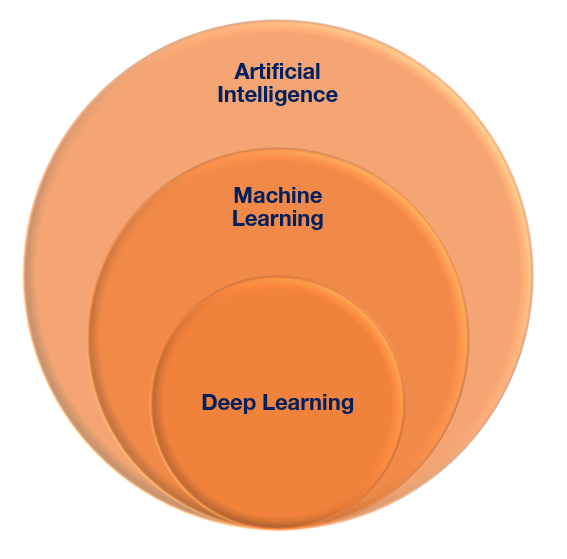It seems like every time you read a newspaper, magazine, or listen to a podcast, the topic is artificial intelligence (AI). As you keep reading, or listening, you’ll hear some other terms like “machine learning” or “deep learning.” You kind of know they are different but still interrelated, but you aren’t quite sure how. Here is a simple picture to help explain:

Artificial intelligence is the term for many techniques that enable machines to mimic human behavior. As the diagram shows, AI is the most general, high-level term that encompasses the others.
The first, and most simple technique, includes rule- and logic-based programming. Here humans define the patterns. For example, with language tasks, these lexicons are rules-based models that perform simple word or phrase comparison exercises. They recall from lists that define a few hundred to a few thousand potentially problematic words and/or phrases. While rule- and logic-based methods are good for some problems, they may not be ideal for more complex problems that span beyond a list of patterns that can be specifically defined.
A more advanced learning-based system is machine learning. Machine learning is called that because it enables computers to learn to recognize complex patterns in data without humans having to explicitly describe all the patterns of interest—the machine isn’t just taught, it learns. There are many categories of machine learning. The three broad categories are supervised learning, unsupervised learning, and reinforcement learning.
- Supervised learning trains the computer on a large set of carefully labeled data to be able to predict the correct output value for unseen inputs. This is often used when historical data can be leveraged to help predict future outcomes, such as fraud detection and speech recognition.
- Unsupervised learning trains an algorithm to find similarities or abnormalities in a data set. This is suited for transactional data.
- Reinforcement learning allows the computer to learn through trial and error from interaction with an environment to get the highest reward. This is often used in gaming and robots.
Deep learning involves more layers of neural networks, where the output of one network becomes the input for the next. And, with deep learning the computer learns from the data which features are most useful in making predictions.
Of course, this is a simplification of a very technical and growing field; but hopefully this gives you a high-level understanding on the interrelatedness of some terms you are hearing.
1063208.2.0







